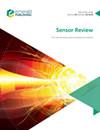Analog-to-digital converters: a review of existing architectures and a new proposal for high resolution sensors
IF 1.4
4区 工程技术
Q3 INSTRUMENTS & INSTRUMENTATION
引用次数: 0
Abstract
Purpose As technology advances the demand for an analog-to digital converter has increased, as every application demands a converter as per its parameters. Currently, work is done on improvement of data converters at three levels of design – architectural, circuit and physical level. This paper aims to review the work done in the field of analog-to-digital converters (ADCs) at architectural and circuit level and discusses the achievements in this field. Furthermore, a new architecture is proposed, which works at higher resolution and provides optimum design parameters at low power consumption. Design/methodology/approach A hybrid architecture combining the features of synthetic approximation register and sigma-delta ADC is presented. The validity of the proposed design at architectural level is verified using MATLAB SIMULINK simulations. Findings The design simulation was tested for a sinusoidal wave of 1 V at the test frequency of 60 Hz. The design consumes least power, and is found to yield an error of the order less than 10–3 V, thus providing highly accurate digital output. Originality/value The design is applicable in many applications including biomedical systems, Internet-of-Things and earthquake engineering. This architecture can be further optimized to obtain better performance parameters.模数转换器:高分辨率传感器的现有架构综述和新建议
目的随着技术的进步,对模数转换器的需求也在增加,因为每个应用程序都需要根据其参数配备转换器。目前,数据转换器的改进工作分为三个设计层面——架构、电路和物理层面。本文旨在回顾在架构和电路层面上在模数转换器(ADC)领域所做的工作,并讨论该领域的成就。此外,还提出了一种新的架构,该架构以更高的分辨率工作,并在低功耗下提供最佳设计参数。设计/方法/途径结合了合成逼近寄存器和∑-ΔADC的特点,提出了一种混合结构。使用MATLAB SIMULINK仿真验证了所提出的设计在体系结构层面的有效性。发现设计模拟是在测试频率为60Hz的1V正弦波下进行测试的。该设计功耗最小,产生的误差小于10–3 V,因此提供了高度准确的数字输出。独创性/价值该设计适用于许多应用,包括生物医学系统、物联网和地震工程。该架构可以进一步优化以获得更好的性能参数。
本文章由计算机程序翻译,如有差异,请以英文原文为准。
求助全文
约1分钟内获得全文
求助全文
来源期刊

Sensor Review
工程技术-仪器仪表
CiteScore
3.40
自引率
6.20%
发文量
50
审稿时长
3.7 months
期刊介绍:
Sensor Review publishes peer reviewed state-of-the-art articles and specially commissioned technology reviews. Each issue of this multidisciplinary journal includes high quality original content covering all aspects of sensors and their applications, and reflecting the most interesting and strategically important research and development activities from around the world. Because of this, readers can stay at the very forefront of high technology sensor developments.
Emphasis is placed on detailed independent regular and review articles identifying the full range of sensors currently available for specific applications, as well as highlighting those areas of technology showing great potential for the future. The journal encourages authors to consider the practical and social implications of their articles.
All articles undergo a rigorous double-blind peer review process which involves an initial assessment of suitability of an article for the journal followed by sending it to, at least two reviewers in the field if deemed suitable.
Sensor Review’s coverage includes, but is not restricted to:
Mechanical sensors – position, displacement, proximity, velocity, acceleration, vibration, force, torque, pressure, and flow sensors
Electric and magnetic sensors – resistance, inductive, capacitive, piezoelectric, eddy-current, electromagnetic, photoelectric, and thermoelectric sensors
Temperature sensors, infrared sensors, humidity sensors
Optical, electro-optical and fibre-optic sensors and systems, photonic sensors
Biosensors, wearable and implantable sensors and systems, immunosensors
Gas and chemical sensors and systems, polymer sensors
Acoustic and ultrasonic sensors
Haptic sensors and devices
Smart and intelligent sensors and systems
Nanosensors, NEMS, MEMS, and BioMEMS
Quantum sensors
Sensor systems: sensor data fusion, signals, processing and interfacing, signal conditioning.
 求助内容:
求助内容: 应助结果提醒方式:
应助结果提醒方式:


